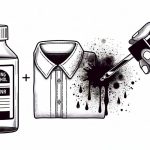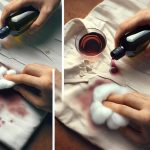Tackling black spots on fabrics can be like trying to catch a greased pig – frustrating and futile. But fear not, for where there's a will, there's a way. You've come to the right place to master the art of banishing those stubborn spots for good.
In this guide, we'll explore five effective methods to rid your fabrics of those pesky black marks. From using natural ingredients like lemon juice and baking soda to harnessing the power of hydrogen peroxide and rubbing alcohol, you'll learn the secrets to restoring your fabrics to their former glory.
So, roll up your sleeves and get ready to bid farewell to those unsightly spots once and for all.
Key Takeaways
- Lemon juice and sunlight method can be used to remove black spots from fabrics by applying fresh lemon juice onto the affected areas and drying the fabric in direct sunlight.
- Baking soda and vinegar solution is an effective method for stain removal by creating a paste-like consistency and allowing it to sit on the fabric before washing.
- Hydrogen peroxide and dish soap can be combined to create a stain-fighting solution, but it is important to test it on a small area first and rinse the treated area thoroughly.
- Rubbing alcohol can be used for spot treatment by gently dabbing it on the stain and washing the fabric according to care instructions afterwards.
Lemon Juice and Sunlight Method
You can remove black spots from fabrics using the lemon juice and sunlight method. This natural remedy offers several benefits for fabric cleaning.
Lemon juice, with its acidic properties, acts as a bleaching agent, effectively lightening and removing black spots from fabrics. When combined with sunlight, the citric acid in lemon juice is activated, enhancing its stain-lifting power. The ultraviolet (UV) rays from the sun further aid in breaking down the dark spots, making this method an effective alternative to chemical-based fabric cleaners.
To utilize this method, start by applying fresh lemon juice directly onto the affected areas of the fabric. Then, place the fabric in direct sunlight, allowing it to dry naturally.
The combination of lemon juice and sunlight not only removes black spots but also leaves the fabric with a fresh, citrusy scent. This natural approach is particularly beneficial for delicate fabrics that may be sensitive to harsh chemicals. Moreover, it's an eco-friendly option, aligning with the increasing preference for sustainable and natural cleaning methods.
Baking Soda and Vinegar Solution
Try applying a baking soda and vinegar solution to the affected areas of the fabric to effectively remove black spots. This natural cleaning method can be a powerful way to tackle stubborn stains. Here's how you can use this solution to restore your fabrics:
- Mix the Solution: Combine equal parts of baking soda and vinegar to create a paste-like consistency. Make sure the mixture is well blended before application.
- Apply to Stained Areas: Gently massage the solution onto the black spots on the fabric. Ensure that the affected areas are completely covered with the solution.
- Let It Sit: Allow the solution to sit on the fabric for at least 30 minutes. This will give it time to penetrate the fibers and break down the stains.
- Wash as Usual: After the solution has had time to work its magic, wash the fabric as you normally would. Check to see if the black spots have disappeared before drying the fabric.
Using a baking soda and vinegar solution can be an effective method for stain removal, and it's a great way to clean fabrics using natural cleaning methods.
Hydrogen Peroxide and Dish Soap Technique
To continue treating stubborn black spots on fabrics, begin by combining equal parts of hydrogen peroxide and dish soap to create a potent stain-fighting solution. This technique is particularly effective for lifting tough stains while being gentle on most fabric colors. When using this method, it's important to prioritize fabric color preservation.
To do this, test the solution on a small, inconspicuous area of the fabric first to ensure that it doesn't cause any discoloration. Additionally, it's crucial to thoroughly rinse the treated area after stain removal to prevent any residue from affecting the fabric color over time.
Incorporating stain prevention techniques into your fabric care routine can also help minimize the need for aggressive stain-fighting methods. This includes promptly treating stains as soon as they occur, avoiding rubbing or pressing the stain further into the fabric, and using color-safe and gentle cleaning products.
Rubbing Alcohol Spot Treatment
If the hydrogen peroxide and dish soap technique didn't fully remove the black spots, consider using rubbing alcohol as an alternative spot treatment for stubborn stains on fabrics.
Rubbing alcohol can be an effective solution for removing black spots from fabrics, but it's important to consider fabric compatibility and stain size before proceeding. Here's how to use rubbing alcohol as a spot treatment:
- Fabric Compatibility: Before applying rubbing alcohol to the stained area, test it on a small, inconspicuous part of the fabric to ensure that it won't cause any damage or discoloration.
- Stain Size: For larger stains, start by blotting the affected area with a clean cloth to absorb any excess liquid. Then, apply rubbing alcohol to a clean cloth and gently dab at the stain, working from the outside in to prevent it from spreading.
- Once the stain has lifted, wash the fabric according to the care instructions. If the stain persists, consider repeating the rubbing alcohol treatment or seeking professional help.
- Caution: Always work in a well-ventilated area when using rubbing alcohol and avoid exposing it to open flames or heat sources.
Oxygen-Based Bleach Soak
To effectively remove black spots from fabrics, begin by soaking the stained area in an oxygen-based bleach solution for at least 30 minutes. Oxygen-based bleach, such as hydrogen peroxide or sodium percarbonate, is a powerful stain remover that's gentle on fabrics. It works by breaking down the chemical bonds of the stain molecules, making it easier to lift the discoloration from the fabric fibers.
When using an oxygen-based bleach soak, it's essential to consider fabric color preservation. Unlike traditional chlorine bleach, oxygen-based bleach is less likely to cause color fading or damage to the fabric. This makes it a suitable option for treating colored or patterned fabrics without compromising their appearance.
Moreover, oxygen-based bleach is known for its reduced environmental impact compared to chlorine bleach. It breaks down into oxygen, water, and natural soda ash, making it safer for the environment and the health of those using it.
Frequently Asked Questions
Can These Methods Be Used on All Types of Fabrics, Including Delicate or Sensitive Materials?
When trying to remove black spots from fabrics, it's important to consider the effectiveness on delicate fabrics. Always take precautions for sensitive materials by spot testing and using gentle methods to avoid damage.
Are There Any Potential Negative Effects or Risks Associated With Using These Methods on Fabrics?
When removing black spots from fabrics, potential risks might include fabric sensitivity and long-term effectiveness. Certain methods may not be suitable for specific stain types or delicate materials. Always consider these factors before treatment.
How Long Does It Typically Take for These Methods to Completely Remove Black Spots From Fabrics?
Typically, it takes a few hours to completely remove black spots from fabrics using gentle methods. This timeframe ensures effectiveness on delicate fabrics. Always test on a small, inconspicuous area first to avoid any potential damage.
Can These Methods Be Used to Remove Other Types of Stains or Discoloration From Fabrics, or Are They Specifically for Black Spots?
Yes, these methods can effectively remove other types of stains and discoloration from fabrics. However, it's important to consider fabric sensitivity when using these methods to ensure they won't cause damage.
Are There Any Specific Types of Black Spots or Stains That These Methods May Not Be Effective for Removing?
When dealing with black spots on fabrics, consider the types of stains and fabric. Some methods may have limitations in effectively removing certain types of black spots, especially on delicate materials. Explore alternative methods for best results.
- Recycling Nonwoven Fabrics: Is It Possible? - July 11, 2025
- Recycling Nonwoven Fabrics: Is It Possible? - July 11, 2025
- Recycling Nonwoven Fabrics: Is It Possible? - July 11, 2025







